
From Screens to Hearts: Analyzing Movie Emotions with Emotion AI
Welcome to the second part of our journey, where we explore how emotion AI software is revolutionizing the analysis of movie emotions. Join us as we embark on a deeper psychological and interpretive analysis of iconic movie clips. In each frame, dialogue, and gesture lies profound meaning waiting to be uncovered.
With our cutting-edge Emotion Recognition technology, you can decode the emotional impact of films like never before. Our emotion AI tool helps you identify and quantify the emotions that movies evoke in us.
Let's continue our exploration; we’ve got five more movie clips to analyze.
The Matrix
The red pill/blue pill scene in "The Matrix" sticks in everyone's mind because it captures a choice between facing the truth or staying ignorant. So, this choice between the red and blue pills resonates with audiences profoundly, tapping into universal themes of curiosity, awakening, and the quest for truth.
Some analysts have even argued that *Plato's Allegory of the Cave foreshadows the red pill/blue pill scene in "The Matrix," both symbolizing a journey from ignorance to enlightenment.
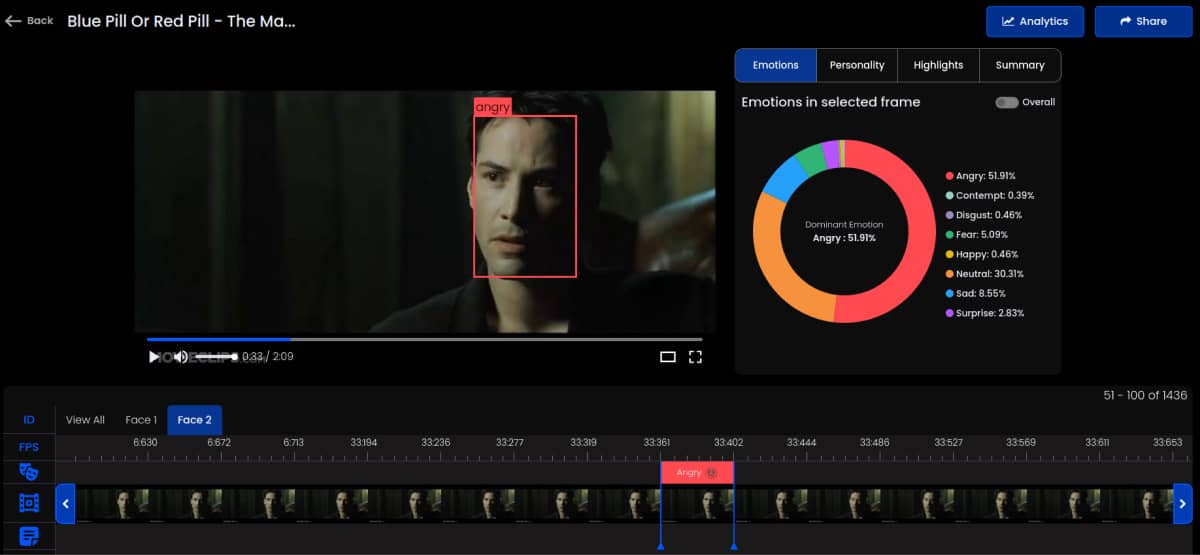
Imentiv AI’s psychological analysis of this scene says that in a video where actors maintain neutral expressions amid an emotionally charged atmosphere, psychological tension unfolds. The contrast between calm faces and intense surroundings sparks curiosity, inviting viewers to delve into the character's true emotions. This interplay keeps the audience engaged as they navigate between apparent tranquility and underlying intensity, creating suspense and turning the video into a thought-provoking experience.

On the other hand, the personality analysis of this video, marked by elevated levels of agreeableness and *neuroticism offers a distinct psychological lens.
High agreeableness hints at a focus on cooperation and empathy, potentially addressing sensitive issues for harmonious storytelling. Simultaneously, heightened neuroticism contributes to the emotional instability sensed in the video's tense ambiance, adding complexity to the narrative.
The Silence of the Lambs
The phone call scene in "The Silence of the Lambs" is an intense moment in the film. The atmosphere is charged with suspense as Clarice engages in a tense conversation with Lecter.
This psychological horror-thriller film follows FBI trainee Clarice Starling, played by Jodie Foster, as she seeks the help of the brilliant but insane Dr. Hannibal Lecter, portrayed by Anthony Hopkins, to apprehend another serial killer named Buffalo Bill.
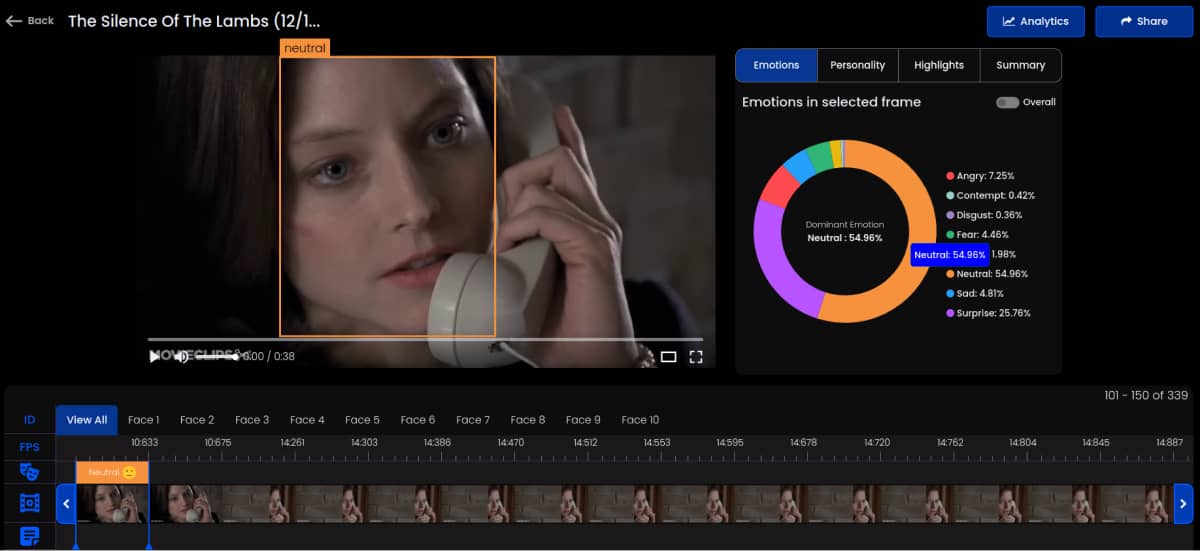
Imentiv AI (an Emotion AI Software) analyzes the movie clip, revealing a person with a neutral facial expression masking a rich inner world driven by curiosity. This suggests a skill in concealing true feelings, likely due to social awareness or learned emotional control. The curiosity stems from a deep desire to explore or understand something specific, showcasing the balance between external composure and internal intellectual fervor.
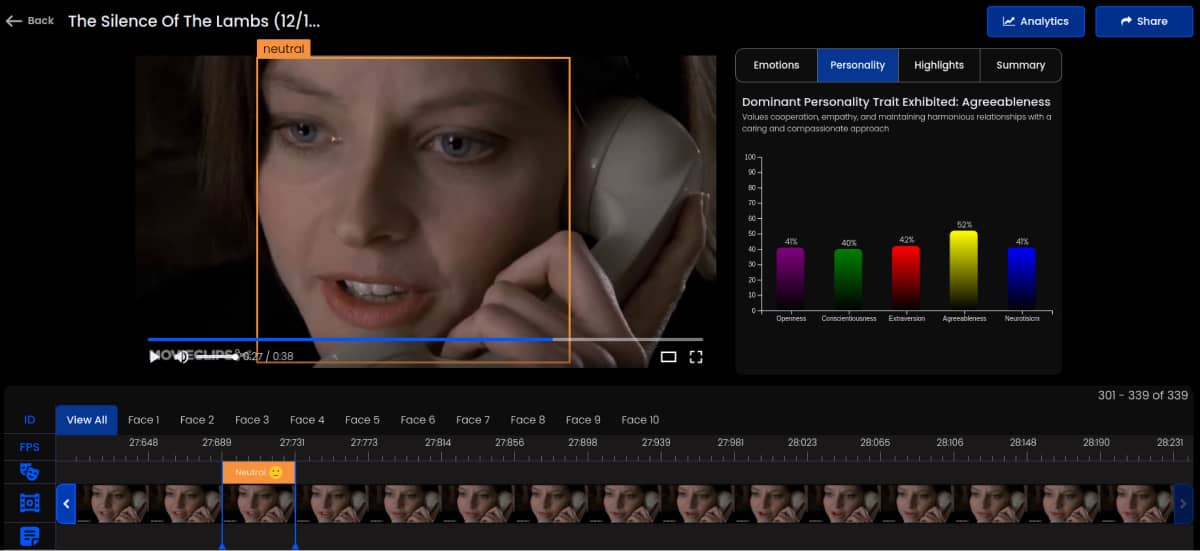
Personality-wise, the video presents as agreeable and cooperative, fostering relatability. Its outgoing and enthusiastic vibe, despite maintaining a neutral tone, draws viewers in, creating an inviting and engaging experience. This combination enhances the overall appeal of the content, making it informative and enjoyable for the audience.
The Good the Bad the Ugly
The Good, the Bad and the Ugly builds suspense throughout, especially in its iconic standoffs and duels. The characters' moral ambiguity heightens tension, blurring traditional notions of good and bad, and crafting a complex emotional landscape for the audience.
The movie is also a deeply philosophical film. It explores themes such as greed, violence, and the nature of good and evil. The film is also a meditation on the American Civil War and the legacy of slavery.
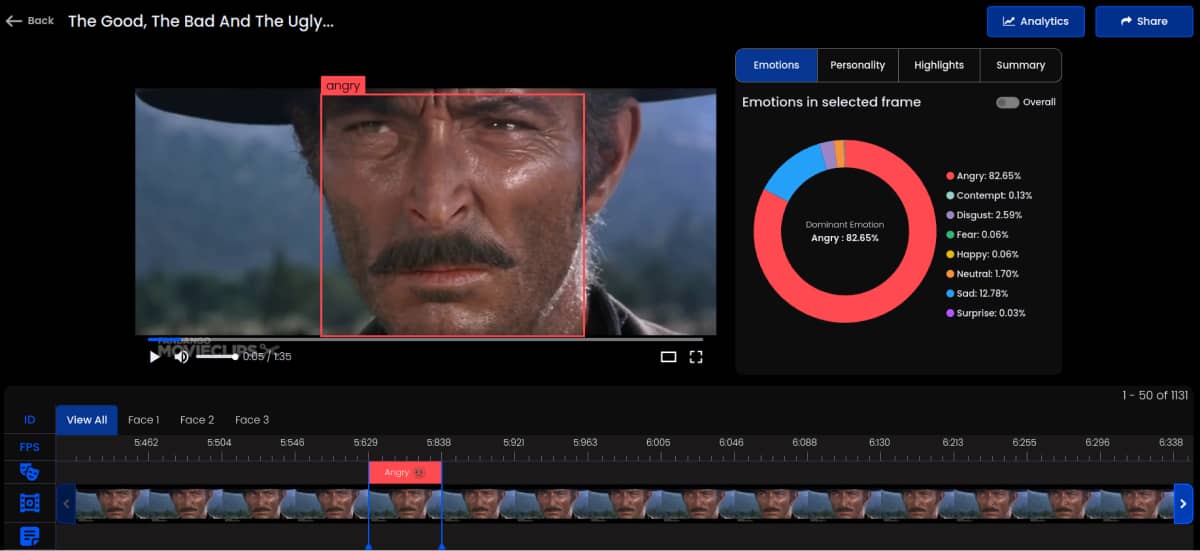
Our Emotion AI has analyzed the scene and found that the characters are prominently displaying anger on their faces. This creates an overall atmosphere of palpable tension, which is likely due to unresolved conflicts or imminent confrontations.

This tension engages the audience, hinting at the potential for intense emotional interactions and conflict-driven plot developments.
The personality analysis of the video displays high levels of agreeableness, openness to experience, and neuroticism. This is a fascinating juxtaposition of characteristics, as agreeableness suggests a desire for harmony and cooperation, but when blended with anger, it signifies a strong need for justice and fairness, possibly in response to perceived wrongs or injustices.
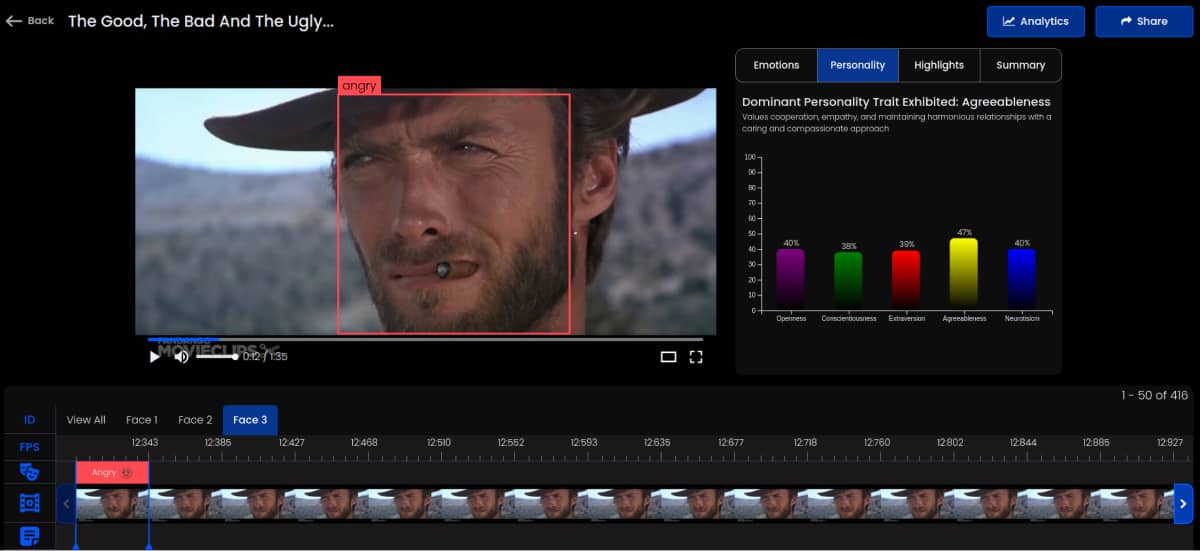
The video's openness trait indicates a willingness to explore new ideas and challenge norms, while the presence of neuroticism, which signifies emotional sensitivity, suggests that the video's anger is authentic and deeply felt. Viewers may empathize with this emotional intensity, even if they don't share the same perspective.
Altogether, this video's personality traits and emotional expression create a passionate and authentic discourse. Striking a balance between conveying its message effectively and maintaining a respectful tone is crucial for its impact and audience engagement.
A Few Good Men
Some movies stay with you long after you have seen them, and ‘A Few Good Men’ is one among them. The film features some of the most memorable courtroom scenes in cinema history, including the final scene in which Kaffee confronts Jessup and proves that he ordered Santiago's murder. These scenes are well-written, well-acted, and incredibly suspenseful.
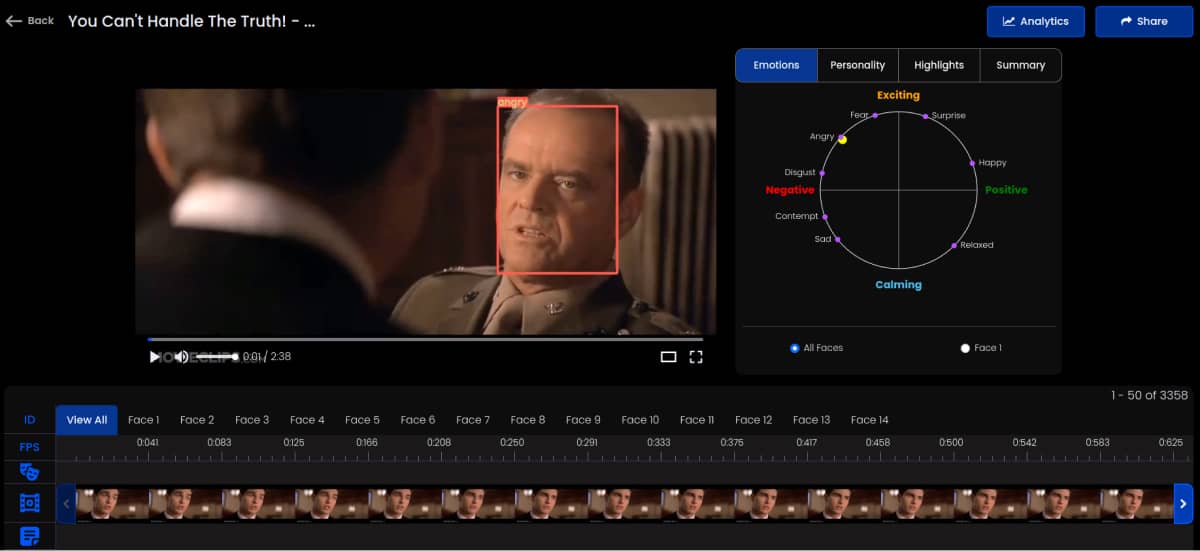
"You can't handle the truth!" and "I want the truth!" dialogs are sharp and explore themes of honor, duty, and the harsh realities of military life. The memorable line has become iconic, symbolizing the clash between the quest for justice and the harsh truths that some may find difficult to accept.
In the courtroom scene of this movie, through the lens of Imentiv AI, emotions are on full display, creating a dramatic and tension-filled atmosphere. The actor's portrayal of anger adds a layer of complexity to the scene, reflecting a response to perceived injustice, frustration, or opposition. This emotion contributes to an overarching tension, amplified by nonverbal cues such as tensed muscles and raised voices.
The courtroom's social and interpersonal dynamics come into play, with the actor's emotional display influencing others and creating a ripple effect of emotions. The audience's response varies, with some feeling tension and anxiety while others empathize with the actor's anger.
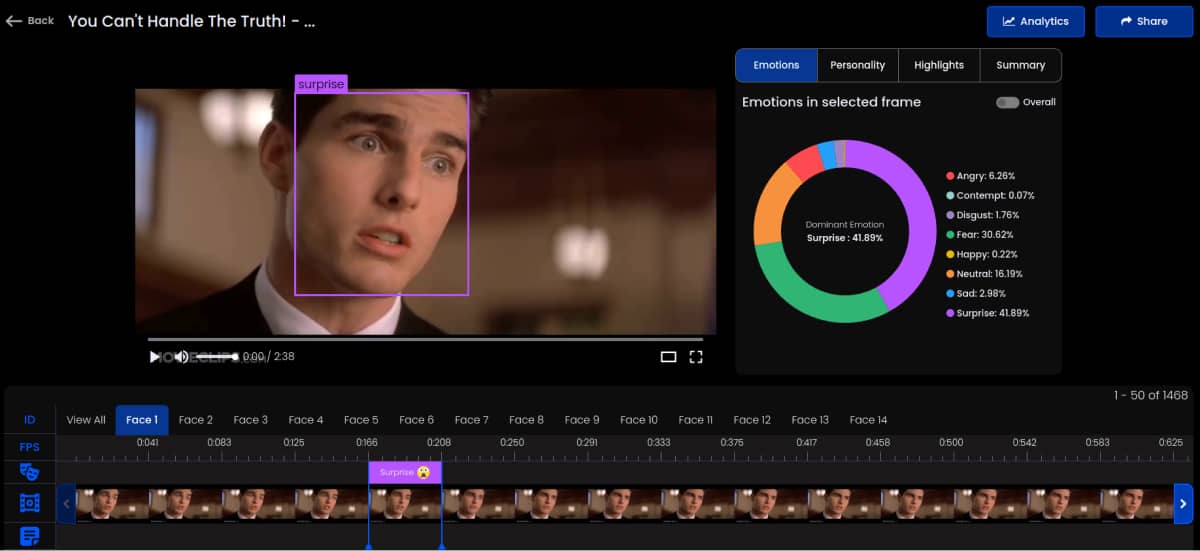
Through effective narration and storytelling, the video captures the web of emotions, interpersonal relationships, and the weight of the legal system in this intense scenario.
In terms of personality analysis, the dominant emotion of anger aligns with heightened neuroticism, indicating emotional instability and susceptibility to stress.

The openness trait is reflected in the complex nature of the legal proceedings, requiring intellectual flexibility and adaptability. The combination of these personality traits intensifies the emotional and psychological drama, making it a compelling and captivating courtroom scene.
The Tourist

Johnny Depp is a master of conveying emotions on screen, and he does so to great effect in the movie "The Tourist." His character, Frank, is a complex and emotionally conflicted man.
In this video where actors chat casually while traveling, our AI analysis looks at the emotions and traits they show. The predominant emotional tone is one of neutrality, creating an atmosphere of ease and comfort. The actors' expressions likely include relaxed facial features and open body language, signifying a lack of stress or tension.

Yet, a hint of flirtiness and light tension makes the interaction more interesting. They're playfully teasing each other, making the atmosphere enjoyable and light.
The actors in the video show personality traits like openness, agreeableness, and extraversion. Being open means they're ready to talk about many things and agreeable means they're kind and cooperative, making the atmosphere positive. Extraversion means they're outgoing and social, making the interaction lively and energetic.
The psychological impact of this video on viewers is likely to evoke feelings of warmth and amusement. The blend of lightheartedness, friendly banter, and underlying tension creates a relatable and enjoyable viewer experience.

The interplay of neutral emotions and flirtatious undertones, coupled with the portrayal of personalities characterized by openness, agreeableness, and extraversion, contributes to an entertaining psychological journey for the audience.
After going through the emotion analysis of these movie clips, you might start thinking about how certain movies became your favorites, and some scenes never faded in your mind.
What emotional element made you stick to it?
Emotion AI, like Imentiv AI, offers an enhanced approach to grasp the emotional subtleties of a video, delving into the emotions and personalities, backed by renowned psychological theories.
We hope you enjoyed learning about Imentiv AI's role in analyzing emotional impact across various movie clips, helping viewers better understand and relate to different cinematic experiences.
Experience the power of Emotion AI and take your movie analysis to the next level with our video emotion recognition tool.
Unlock the emotional impact of movies with Imentiv AI, an Emotion Recognition Technology.
Glossary
* Neuroticism:Neuroticism is a key personality trait in the Five-Factor Model, characterized by heightened levels of negative emotions and emotional instability.
*Plato's Allegory of the Cave: Plato's Allegory of the Cave is like a story that shows how people can learn and understand new things. It's about prisoners in a dark cave who think shadows on a wall are real until one of them goes outside and sees the real world.